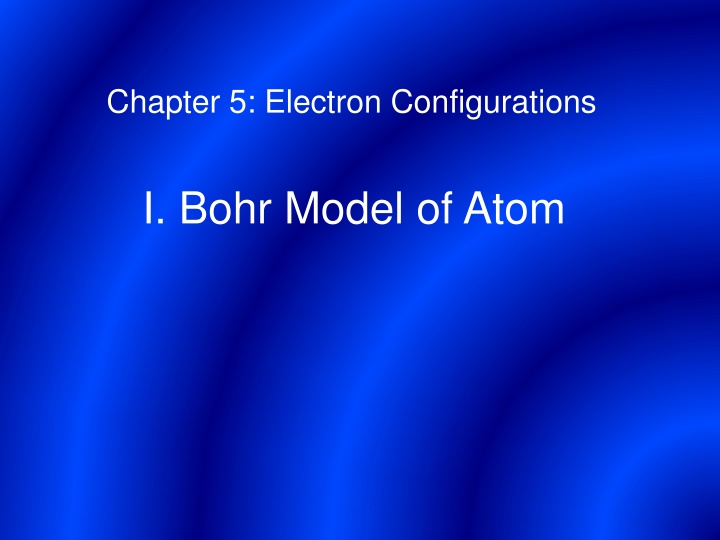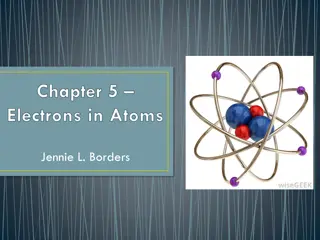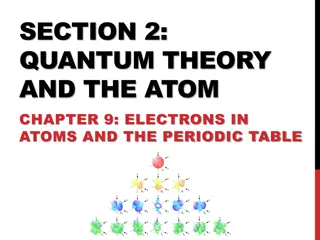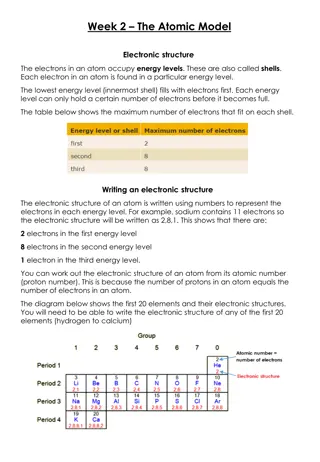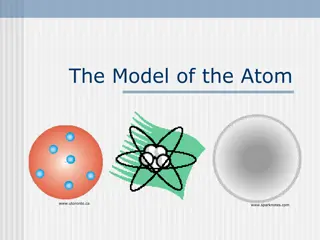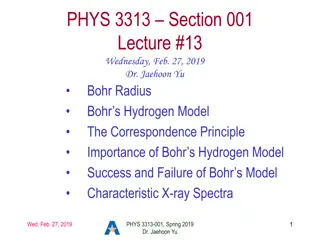Bohr Model of Atom and Line Spectra - Early Quantum Theories
In the 1800s, electrons and light were explored as particles and waves, leading to the development of quantum physics. The Bohr model introduced electron orbits, and line spectra analysis helped understand atomic structures, with elements identified by unique line spectra patterns. Quantum mechanics furthered these ideas, proposing a dual wave-particle nature for matter. Explore the evolution of atomic theory from the Bohr model to the quantum model, examining the relationships between electrons, light, and energy levels within atoms.
Uploaded on Mar 01, 2025 | 1 Views
Download Presentation

Please find below an Image/Link to download the presentation.
The content on the website is provided AS IS for your information and personal use only. It may not be sold, licensed, or shared on other websites without obtaining consent from the author.If you encounter any issues during the download, it is possible that the publisher has removed the file from their server.
You are allowed to download the files provided on this website for personal or commercial use, subject to the condition that they are used lawfully. All files are the property of their respective owners.
The content on the website is provided AS IS for your information and personal use only. It may not be sold, licensed, or shared on other websites without obtaining consent from the author.
E N D
Presentation Transcript
Chapter 5: Electron Configurations I. Bohr Model of Atom
1800s: Electrons were thought of as particles; light was thought of as waves. Experimental observations can support both these theories. Early 1900 s: New experiments showed that electrons have some wave-like properties and light has some particle-like properties. These discoveries led to the idea that both electrons and light have a dual wave-particle nature. (This was the beginning of quantum physics.)
Prisms A prism can be used to spread out the wavelengths of light.
Line Spectra 2. Line Spectra Animation 1. Physics 2000 Quantum Atom - Line Spectra
Line Spectra (bright-line spectra, atomic emission spectra) 1. Line Spectra ( or bright-line spectra) these lines of color are produced when the light from an element is passed through a prism. 2. Each element produces a characteristic set of lines called the line spectrum of the element. Elements can be identified by their line spectrum. 3. Each line in a line spectrum represents a particular wavelength and frequency of light given off. You can calculate the energy of the photons of light using E=h 4. Bohr used the line spectrum of hydrogen to devise his model of the atom.
In the Bohr model of the atom, electrons were found in orbits. Orbits the specific circular paths an Electron can follow around the nucleus. When atoms absorb energy, electrons jump to higher energy orbits. Then the electrons fall back down and give off the energy as light/
Ground State when electrons are in the lowest possible energy level. Excited State when electrons are in Higher energy levels than the Ground state.
II. Quantum Model of Atom Quantum Mechanics A. (1924) Louis de Broglie says if light has a dual wave-particle nature, then matter (electrons) could also have a dual wave-particle nature.
Experiments showed that electrons display the wave properties of diffraction and interference. Electron Interference Animation(Web) Drive
B. Heisenberg Uncertainty Principle It is impossible to know exactly both the location and velocity of an electron at the same time.
C. Schrodinger Wave Equation Describes the probability of where an electron can be found. Schrodinger s equation works for all atoms. D. Quantum theory describes mathematically the wave properties of electrons. In the quantum model of the atom, electrons are found in orbitals, not specific orbits.
In the Quantum model, electrons are found in Orbitals Orbital the three dimensional area where an electron can be found. Quantum numbers tell you the address of orbitals and electrons.
Electrons fill lowest energy orbitals first. Each orbital can hold 2 electrons.
Principle Quantum Number (n) tells you what shell (main energy level) an orbital is in. n=6 n=5 n=4 n=3 Energy n=2 n = 1 V.Montgomery & R.Smith 16
Azimuthal Quantum number tells you the shape (what sublevel) the orbital is in. The sublevels are: s, p, d, and f in order of increasing energy.
s orbital One s orbital per shell
p orbitals Three p orbitals per shell
d orbitals Five d orbitals per shell
f orbitals Seven f orbitals per shell f orbitals 1st appear in the 4th shell
